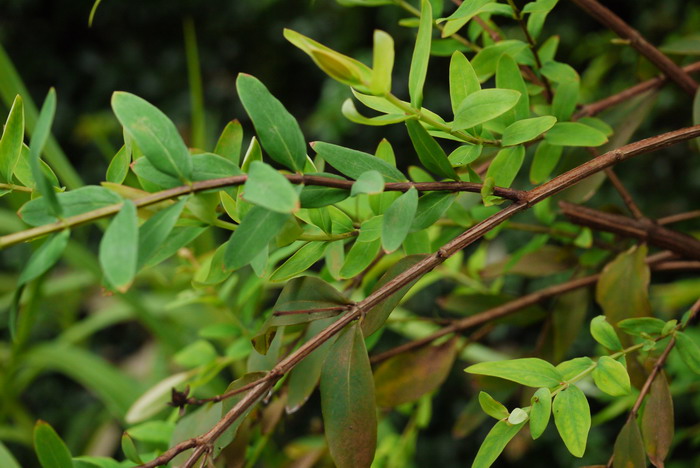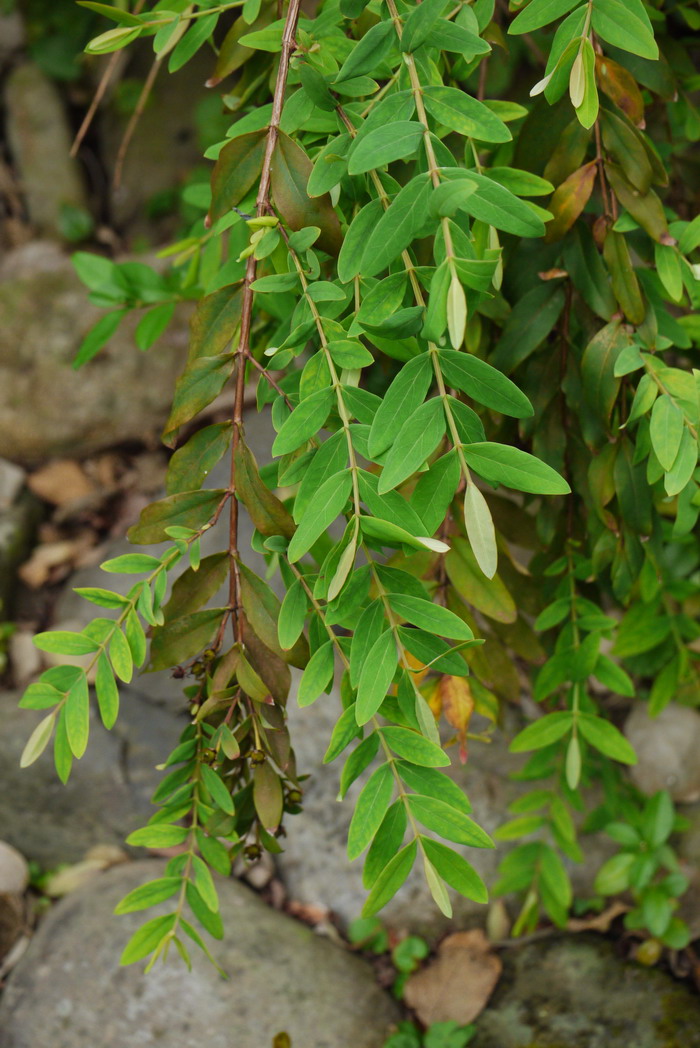方茎金丝桃Hypericum subalatum
中文名(Chinese Name):方茎金丝桃
学名(Scientific Name):Hypericum subalatum Hayata
英文名(English Common Name):
别名(Chinese Common Name):
异名(Synonym):. Hypericum kushakuense R. Keller Takasagoya subalata (Hayata) Y. Kimura
科属(Family & Genus):藤黄科(Guttiferae)金丝桃属Hypericum
形态特征(Description):灌木,高50厘米以上,有多少上升枝条。茎持久地4棱形至具4 狭翅;节间长1-2.5厘米,短于叶;皮层红褐色。叶无柄;叶片狭椭圆形至披针形或狭长圆状椭圆形,长1.9-7 厘米,宽0.5-1.6厘米,先端锐尖至近锐尖或圆形而具小尖突,基部楔形,边缘平坦,坚纸 质,上面绿色,下面淡绿但不呈苍白色,主侧脉2-3对,有时形成明显的近边缘脉,中脉有 6-7条羽状分枝,第三级脉网纤细或几不可见,近边缘腺体密生,叶片腺点明显。花序1花,在茎及自其顶端向下达至6节上生出的短侧枝上顶生,花梗长0.6-1.2厘米;小苞片叶状至钻形,凋落。花直径约2.5厘米,近星状;花蕾卵珠形,先端锐尖。萼片分离或近分离,在花蕾及结果时直立,长圆状线形至椭圆形或倒披针形,近等大或不等大,长5-8毫米,宽(-2)(-3)毫米,先端近锐尖至锐尖或短渐尖,具7-9脉,中脉多少模糊,小脉少分枝,腺体大多为线形。花瓣亮黄色,有红晕,多少开张,倒卵形,长1-2厘米,宽0.6厘米,有近消失的小尖突。雄蕊5束,每束有雄蕊约15枚,最长者长0.9-1厘米,长约为花瓣的4/5。子房多少呈狭卵珠形,长2-4毫米,宽0.7-1.3毫米;花柱长(3.3-)4-7毫米,长约为子房的2-2.5倍,柔弱,柱头头状。蒴果狭卵珠形至圆柱形,长7-9毫米,宽3-4毫米。种子深黄褐色,狭圆柱形或狭卵珠状圆柱形,长0.9-1.1毫米,几无龙骨状突起但有长而狭的顶端附属物,有很浅的线状网纹。花期1-3月,果期8月。
分布(Distribution):产台湾(台北、宜兰、花莲)。生于开旷石灰岩岩隙中,海拔400-900米。模式标本采自台湾台北。
用途(Use):
引自中国植物志英文版FOC Vol. 13 Page 2, 19 Login
Hypericum subalatum Hayata, J. Coll. Sci. Imp. Univ. Tokyo. 30(1): 41. 1911.
方茎金丝桃 fang jing jin si tao| Clusiaceae | Hypericum
Hypericum kushakuense R. Keller; Takasagoya subalata (Hayata) Y. Kimura.
Shrubs, more than 0.5 m tall; branches ± ascending. Stems persistently 4-angled or narrowly 4-winged; internodes 1-2.5 cm, shorter than leaves. Leaves sessile; blade narrowly elliptic to lanceolate or narrowly oblong-elliptic, 1.9-7 × 0.5-1.6 cm, thickly papery, abaxially paler but not glaucous; laminar glands dots, prominent; abaxial glands absent; main lateral veins 2- or 3-paired, sometimes forming intramarginal vein, tertiary reticulation faint or nearly invisible; base cuneate, apex acute to subacute or rounded-apiculate. Inflorescence 1-flowered, terminal and on short subsidiary branches from up to ca. 6 nodes below; bracts leaflike, bracteoles leaflike to subulate, entire, deciduous. Pedicels 6-12 mm. Flowers ca. 2.5 cm in diam., substellate; buds ovoid, apex acute. Sepals free or nearly so, erect, subequal to unequal, oblong-linear to elliptic or oblanceolate, 5-8 × 1-2(-3) mm, laminar glands mostly lines, margin entire, apex subacute to acute or short acuminate. Petals bright yellow, tinged red, obovate, 1-2 cm × ca. 6 mm, 1.5-2 × as long as sepals; margin entire, eglandular; apiculus obsolete. Stamen fascicles each with ca. 25 stamens, longest 9-10 mm, ca. 0.8 × as long as petals. Ovary ± narrowly ovoid, 2-4 × 0.7-1.3 mm; styles (3.3-)4-7 mm, 2-2.5 × as long as ovary; stigmatic mass capitate. Capsule narrowly ovoid to cylindric, 7-9 × 3-4 mm, ca. 2 × as long as sepals. Seeds dark yellowish brown. 0.9-1.1 mm, with long terminal expansion; testa linear-reticulate. Fl. Mar-Jul, fr. Aug-Jan.
● Open limestone rock crevices; 400-900 m. E and N Taiwan (Hualian, Ilan, Taibei).

 (责任编辑:徐晔春)
(责任编辑:徐晔春)
学名(Scientific Name):Hypericum subalatum Hayata
英文名(English Common Name):
别名(Chinese Common Name):
异名(Synonym):. Hypericum kushakuense R. Keller Takasagoya subalata (Hayata) Y. Kimura
科属(Family & Genus):藤黄科(Guttiferae)金丝桃属Hypericum
形态特征(Description):灌木,高50厘米以上,有多少上升枝条。茎持久地4棱形至具4 狭翅;节间长1-2.5厘米,短于叶;皮层红褐色。叶无柄;叶片狭椭圆形至披针形或狭长圆状椭圆形,长1.9-7 厘米,宽0.5-1.6厘米,先端锐尖至近锐尖或圆形而具小尖突,基部楔形,边缘平坦,坚纸 质,上面绿色,下面淡绿但不呈苍白色,主侧脉2-3对,有时形成明显的近边缘脉,中脉有 6-7条羽状分枝,第三级脉网纤细或几不可见,近边缘腺体密生,叶片腺点明显。花序1花,在茎及自其顶端向下达至6节上生出的短侧枝上顶生,花梗长0.6-1.2厘米;小苞片叶状至钻形,凋落。花直径约2.5厘米,近星状;花蕾卵珠形,先端锐尖。萼片分离或近分离,在花蕾及结果时直立,长圆状线形至椭圆形或倒披针形,近等大或不等大,长5-8毫米,宽(-2)(-3)毫米,先端近锐尖至锐尖或短渐尖,具7-9脉,中脉多少模糊,小脉少分枝,腺体大多为线形。花瓣亮黄色,有红晕,多少开张,倒卵形,长1-2厘米,宽0.6厘米,有近消失的小尖突。雄蕊5束,每束有雄蕊约15枚,最长者长0.9-1厘米,长约为花瓣的4/5。子房多少呈狭卵珠形,长2-4毫米,宽0.7-1.3毫米;花柱长(3.3-)4-7毫米,长约为子房的2-2.5倍,柔弱,柱头头状。蒴果狭卵珠形至圆柱形,长7-9毫米,宽3-4毫米。种子深黄褐色,狭圆柱形或狭卵珠状圆柱形,长0.9-1.1毫米,几无龙骨状突起但有长而狭的顶端附属物,有很浅的线状网纹。花期1-3月,果期8月。
分布(Distribution):产台湾(台北、宜兰、花莲)。生于开旷石灰岩岩隙中,海拔400-900米。模式标本采自台湾台北。
用途(Use):
引自中国植物志英文版FOC Vol. 13 Page 2, 19 Login
Hypericum subalatum Hayata, J. Coll. Sci. Imp. Univ. Tokyo. 30(1): 41. 1911.
方茎金丝桃 fang jing jin si tao| Clusiaceae | Hypericum
Hypericum kushakuense R. Keller; Takasagoya subalata (Hayata) Y. Kimura.
Shrubs, more than 0.5 m tall; branches ± ascending. Stems persistently 4-angled or narrowly 4-winged; internodes 1-2.5 cm, shorter than leaves. Leaves sessile; blade narrowly elliptic to lanceolate or narrowly oblong-elliptic, 1.9-7 × 0.5-1.6 cm, thickly papery, abaxially paler but not glaucous; laminar glands dots, prominent; abaxial glands absent; main lateral veins 2- or 3-paired, sometimes forming intramarginal vein, tertiary reticulation faint or nearly invisible; base cuneate, apex acute to subacute or rounded-apiculate. Inflorescence 1-flowered, terminal and on short subsidiary branches from up to ca. 6 nodes below; bracts leaflike, bracteoles leaflike to subulate, entire, deciduous. Pedicels 6-12 mm. Flowers ca. 2.5 cm in diam., substellate; buds ovoid, apex acute. Sepals free or nearly so, erect, subequal to unequal, oblong-linear to elliptic or oblanceolate, 5-8 × 1-2(-3) mm, laminar glands mostly lines, margin entire, apex subacute to acute or short acuminate. Petals bright yellow, tinged red, obovate, 1-2 cm × ca. 6 mm, 1.5-2 × as long as sepals; margin entire, eglandular; apiculus obsolete. Stamen fascicles each with ca. 25 stamens, longest 9-10 mm, ca. 0.8 × as long as petals. Ovary ± narrowly ovoid, 2-4 × 0.7-1.3 mm; styles (3.3-)4-7 mm, 2-2.5 × as long as ovary; stigmatic mass capitate. Capsule narrowly ovoid to cylindric, 7-9 × 3-4 mm, ca. 2 × as long as sepals. Seeds dark yellowish brown. 0.9-1.1 mm, with long terminal expansion; testa linear-reticulate. Fl. Mar-Jul, fr. Aug-Jan.
● Open limestone rock crevices; 400-900 m. E and N Taiwan (Hualian, Ilan, Taibei).
踩一下[0]

顶一下[0]